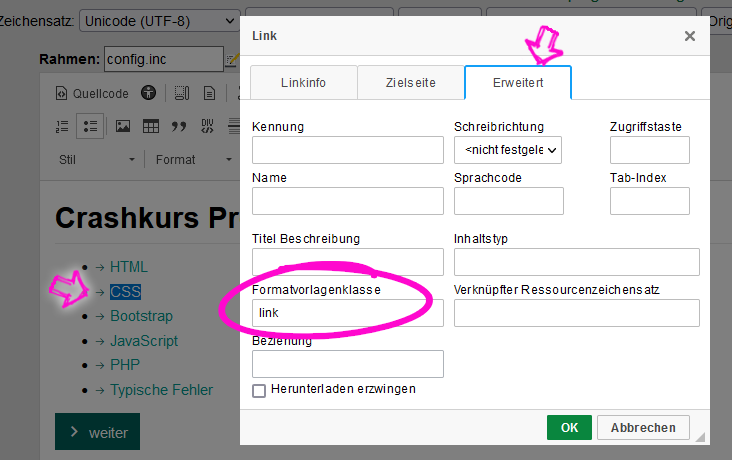Syntax
- Cascading Style Sheets (abbreviation CSS), is a declarative stylesheet language for structured documents
- In a stylesheet definition, HTML tags are assigned layout properties (e. g. fonts, colours, size or position)
- Important principle of CSS: Inheritance of property values to child elements and combination of different stylesheets
- Elements can be identified or addressed on the basis of different properties:
- Element name:
a for all links
- Classes or IDs:
in HTML: <h1 class="special" id="border">
in CSS: h1.special or h1#border
- Position within the document, attributes, position in a set of elements etc.
- Different representations can be specified for different output media (screen, paper, projection, language) – important for Responsive Web Design, among other things
Examples of CSS declarations
/* Overarching for elements */
body {
font-family: Arial,Helvetica,sans-serif;
font-size: 14px;
line-height: 1.6em;
color: #000;
}
p {
margin: 0 0 11px;
}
/* For element classes */
h1.linie {
font-size: 28px;
font-weight: bold;
border-bottom: 1px solid #e6e6e6 !important;
padding: .2em 0 .3em;
text-decoration: none;
}
ul.spacing li {
margin-bottom: .7em;
}
/* For elements with a specific attribute */
.class-tuc a[href] {
color: #177665;
}
/* Elements with position within the document:
Example: :first-child = elements that are the first child of their parent element */
ul li span:first-child {
font-size: x-large;
}
/* Elements with position in a set of elements:
Example: :ntn-child(2n) = every nth (second) child of the parent element */
table.zeile tr:nth-child(2n) {
background-color: #eee;
}
/* Pseudo elements:
Example: ::before = creates an element at the beginning of the element */
.tucicon-link::before {
content: "\2192" "\00a0";
}
Implementation in TUCAL
- Adding a CSS file in the TUCAL frame definition or also for a single page:
$css_in = '@import url(additional.css);'; – imports own CSS file$css_in = 'code {font-weight: bold}'; – Definition of individual styles
- Insert CSS classes for elements:
- In WFM in the field „Formatvorlagenklasse“ (stylesheet class), here using the example of a link:
When creating or editing a link, the class can be entered under „Erweitert“ (advanced).

- For some elements (e. g.
<img>), style specifications can also be entered directly in WFM (in the field „Stil“).
- Otherwise via the source code view in the respective HTML tag as
class="classname".

